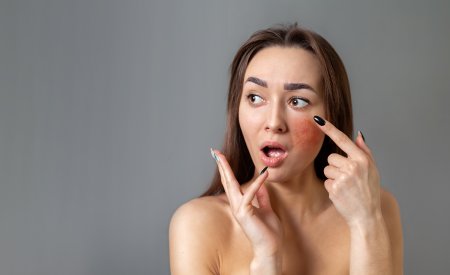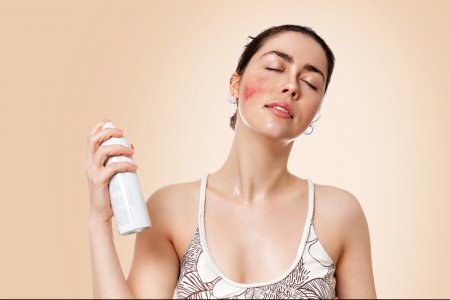Rosacea - All you need to know about this chronic skin condition
Learn more about rosacea, a common skin condition affecting over 3 million Canadians. Discover the causes, symptoms, treatments and preventive measures to better manage your rosacea.

Learn more about rosacea, a common skin condition affecting over 3 million Canadians. Discover the causes, symptoms, treatments and preventive measures to better manage your rosacea.
Rosacea is a chronic skin condition that manifests itself in different forms, each with different symptoms and treatments.
Vascular rosacea or couperose manifests itself as redness on the face accompanied by small blood vessels. This is the most common form of rosacea. Vascular rosacea can be quickly recognized by its precise symptoms:
Hot flushes that trigger facial redness Temporary or permanent redness (erythema or erythosis) Inflammation of the skin on contact with any irritant or allergenic substance Small red or purplish vessels visible on the skin.
Ocular rosacea affects more than half of all rosacea sufferers. It is sometimes the first precursor of other cutaneous rosacea symptoms. Symptoms of ocular rosacea usually include :
Inflammation of the eyelids Conjunctiva Redness Swelling Itching
When rosacea affects the eyes, you may feel a foreign body in the air, with sensitivity to light and visible veins on the eyelid margin.
Papulo-pustular rosacea is characterized by the appearance of small red pimples, also known as papules, which may be filled with pus. Often confused with acne due to the presence of red pimples, papulopustular rosacea is often accompanied by tightness, burning sensations and discomfort. It appears in flare-ups exclusively on the face..
Hypertrophic rosacea is a rather rare form of rosacea, mostly affecting men over the age of 50. It is characterized by a bumpy, deformed nose. Symptoms are easy to identify:
bumpy, red, deformed nose thickening of the skin around the redness
Fulminant rosacea is the most severe form of chronic dermatosis, characterized by the sudden appearance of palpulo-pustular lesions. This type of rosacea can appear within 2 or 3 weeks. Most cases occur in women aged 30 to 40. There seems to be a link between fulminant rosacea and hormonal fluctuations.
The exact cause of rosacea is still unknown, but several hypotheses suggest that it may be due to an anomaly in the skin's protective barrier or a defect in the immune system.
Certain external environmental factors can help trigger rosacea episodes:
Demodex folliculorum is a microscopic parasite found in sebaceous glands, playing an important role in rosacea and promoting inflammatory reactions.
It is the main cause of papulopustular rosacea and ocular rosacea.
Les températures extrêmes, les variations de température et l’exposition au soleil sont responsables des agressions qui viennent troubler la barrière d’hydratation de la peau.
Other inflammatory factors can contribute to the development of rosacea, such as: taking stimulants or coming into contact with irritating substances.
Abuse of alcohol and spicy products is a major factor in the onset of rosacea, and in the dilation of blood vessels that cause redness and heat sensations.
Irritating cosmetics and personal care products are often responsible for the development of rosacea.
Clinical examination is essential to diagnose rosacea. Doctors base their diagnosis on the appearance of the rash. There are no specific tests to determine the presence of rosacea, but the absence of blackheads can help distinguish rosacea from acne.

Rosacea is a chronic condition that can be alleviated with a variety of treatments. Rosacea cannot be cured, but a number of actions can limit symptoms and soothe feelings of discomfort. Treatment varies according to the stage of the disease and the intensity of symptoms:
Certain drug treatments may be prescribed by the physician:
The most commonly used treatment for rosacea is a metronidazole-based antibiotic cream applied to the skin. Applied daily, this antiparasitic and antibacterial cream is prescribed for mild forms of rosacea. When rosacea is associated with eye inflammation, an oral antibiotic such as clindamycin can be taken for 3 months.
Applied to the skin in cream or gel form, azelaic acid helps reduce the number of pustules and diminish redness. It generally takes effect after 4 weeks of application.
Topical tretinoin is used to treat acne. This medication is particularly irritating and is available only on prescription. It takes 4 to 8 weeks for the effects of treatment to appear.
In addition to the topical treatments mentioned above, oral treatments can also be prescribed to limit the symptoms of rosacea:
Oral use of Doxycycline has an anti-inflammatory effect on the skin.
Isotretinoin is a prescription medication used to treat severe forms of rosacea and pustules resistant to other treatments.

La thérapie par la lumière peut aider à soulager la rosacée. Cette technique permet d’exposer la peau à différentes bandes lumineuses et faire ainsi pénétrer la lumière dans l’épiderme. Cela permet aux cellules ciblées d’absorber l’énergie essentielle po
The origin of rosacea remains unknown, but various factors can contribute to the onset of symptoms.
By avoiding the triggers responsible for dilating blood vessels and thinning the skin, you can limit the onset of rosacea and the intensity of symptoms.
Avoid hot drinks, spicy foods and large quantities of alcohol Avoid taking corticosteroids Avoid exposure to extreme climatic temperatures and intense heat sources such as hot baths, saunas and hammams Learn to control your emotions and limit stressful situations
Particularly sensitive to prolonged exposure to the sun, rosacea sufferers should use sunscreen on a daily basis and avoid UV exposure wherever possible. Choose an appropriate high SPF 50 sun protection.
Facial skin is particularly thin and sensitive. It's important to keep aggression and rubbing to a minimum, and to take the following steps:
Use lukewarm water and mild soap to cleanse your face Apply a daily cream to reinforce the skin's moisture barrier and avoid all products containing aggressive ingredients such as acid or alcohol Avoid using cosmetic products (make-up, make-up remover) that can aggravate inflammation